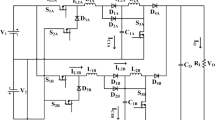Abstract
This paper introduces a constant current control mode (CCM) method for boost DC–DC converters with synchronous rectifiers. The aim is to enlarge the application range, meeting the requirement in markets of mobile power pack (MPP). Historically, the boost DC–DC converters applied in a MPP only have a constant voltage control mode (VCM) loop to provide a fixed output voltage for discharging and usually use short circuit protection to avoid chip damage when the output current exceeds the limitation value. The proposed CCM implemented with a precision buffer for reference voltage and an extra error amplifier has guaranteed a continuous current for loading in the MPP which can strongly enhance the battery life. For a proof of concept, a boost DC–DC converter was implemented with the proposed CCM in a 0.6 μm 5 V BCD SILTERRA process with an area of 2.484 mm2. The experimental results demonstrate steady conversion from VCM to CCM control. Besides, the load current boundary value in CCM achieves a variation within 10 % at both 1 and 2 A load current under different supply voltages which can meet the maximum limit of MPP application.















Similar content being viewed by others
References
Peterchev, A. V., & Sanders, S. R. (2006). Load-line regulation with estimated load-current feed forward: Application to microprocessor voltage regulators. IEEE Transactions on Power Electronics, 21(6), 1704–1717.
Huang, H.-H., Hsieh, C.-Y., Liao, J.-Y., & Chen, K.-H. (2011). Adaptive droop resistance technique for adaptive voltage positioning in boost DC–DC converters. IEEE Transactions on Power Electronics, 26(7), 1920–1932.
Absi, M.-A., & Sabban, I.-A. (2014). A CMOS current-mode squaring circuit free of error resulting from carrier mobility reduction. Analog Integrated Circuits and Signal Processing, 81(1), 23–28.
Lee, C.-S., Ko, H.-H., & Kim, N.-S. (2014). Integrated current-mode DC–DC boost converter with high-performance control circuit. Analog Integrated Circuits and Signal Processing, 80(1), 105–112.
Ferdowsi, M., & Emadi, A. (2014). Estimative current mode control technique for DC–DC converters operating in discontinuous conduction mode. IEEE Power Electronics Letters, 2(1), 20–23.
Guemez, J. G., & Valenzuela, J. M. (2013). Saturated control of boost DC-to-DC power converter. IET Electronics Letters, 49(9), 613–615.
Julio, C. R., & Fernando, M. D. (2013). A transformer-less high-gain boost converter with input current ripple cancellation at a selectable duty cycle. IEEE Transactions on Industrial Electronics, 60(10), 4492–4499.
Kimball, Jonathan W., Flowers, Theresa L., & Chapman, Patrick L. (2004). Low-input-voltage, low-power boost converter design issues. IEEE Power Electronics Letters, 2(3), 96–99.
Woo, Y.-J., Cho, G.-H., & Cho, G.-H. (2007). Power-efficient gate control of synchronous boost converters with high output voltage. IET Electronics Letters, 43(3), 156–157.
Shi, L.-F., & Jia, W.-G. (2014). Mode-selectable high-efficiency low-quiescent-current synchronous buck DC–DC converter. IEEE Transactions on Industrial Electronics, 61(5), 2278–2285.
Yuan, B., Lai, X.-Q., Wang, H.-Y., & Shi, L.-F. (2013). High-efficient hybrid buck converter with switch-on-demand modulation and switch size control for wide-load low-ripple applications. IEEE Transactions on Microwave Theory and Techniques, 61(9), 3329–3338.
P. T. Krein, Elements of Power Electronics. New York: Oxford, 1997.
Li, Y.-J., Lai, X.-Q., Ye, Q., & Yuan, B. (2014). Novel short circuit protection technique for DC–DC buck converters. IET Circuits, Devices and Systems, 8(2), 90–99.
Chen, B.-Y., & Lai, Y.-S. (2012). New digital-controlled technique for battery charger with constant current and voltage control without current feedback. IEEE Transactions on Industrial Electronics, 59(3), 1545–1553.
Raman, J., Rombouts, P., & Weyten, L. (2010). Folded-cascode amplifier with efficient feed-forward gain-boosting. IET Electronics Letters, 46(21), 1425–1426.
Hsieh, C.-Y., Yang, C.-Y., & Chen, K.-H. (2009). A charge-recycling buck-store and boost-restore (BSBR) technique with dual outputs for RGB LED backlight and flashlight module. IEEE Transactions on Power Electronics, 24(8), 1914–1925.
Man, T. Y., Mok, P. K. T., & Chan, M. J. (2008). A 0.9-V Input discontinuous conduction-mode boost converter with CMOS-control rectifier. IEEE Journal of Solid-State Circuits, 43(9), 2306–2346.
Acknowledgments
This work was supported by National Natural Science Foundation of China (No. 61106026).
Author information
Authors and Affiliations
Corresponding author
Rights and permissions
About this article
Cite this article
Du, H., Lai, X. & Liu, C. Design of a synchronous boost DC–DC converter with constant current mode control in MPP. Analog Integr Circ Sig Process 84, 223–235 (2015). https://doi.org/10.1007/s10470-015-0567-2
Received:
Revised:
Accepted:
Published:
Issue Date:
DOI: https://doi.org/10.1007/s10470-015-0567-2




